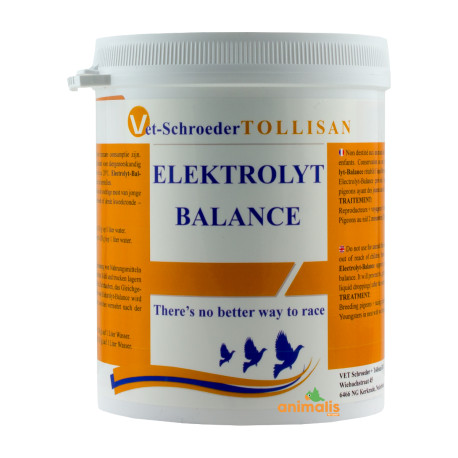



Reference: SCH28
Please note that for orders shipped to countries outside of Europe, additional taxes, customs duties, and fees may apply upon arrival in the destination country.
These charges are the responsibility of the customer and are determined by the local customs authorities.
We recommend checking with your local customs office for more information on potential charges before placing your order.
The administration of electrolytes in racing pigeons has its origins in the practice of sport in humans. It is not always so easy to transpose human products to the animal world.
When playing sports, humans sweat and eliminate salts and electrolytes through their sweat glands. This is why athletes must compensate for this loss for rapid regeneration with the help of electrolyte input. In doing so, the balance is quickly restored.
The administration of electrolytes in racing pigeons has its origins in the practice of sport in humans. It is not always so easy to transpose human products to the animal world.
When playing sports, humans sweat and eliminate salts and electrolytes through their sweat glands. This is why athletes must compensate for this loss for rapid regeneration with the help of electrolyte input. In doing so, the balance is quickly restored.
However, those who want to transpose this principle to racing pigeons forget, however, that the latter do not have sweat glands! By the way, have you ever seen a carrier pigeon returning from a competition flight absolutely soaked?
If pigeons had sweat glands, after a very tiring flight, their plumage would certainly be wet and sticky due to sweating. However, pigeons do not fly well when their plumage is wet. Evolution responded by having the intelligence to simply omit sweat glands in pigeons.
It should also be noted that: during competition flights, racing pigeons suffer from protein (weight) losses and little electrolyte loss. The protein loss should be quickly compensated with highly dosed amino acids such as Med Tollyamin Forte or Tollisol Plus as well as high-quality animal proteins such as Immunol. It should be noted, however, that there is a relevant use of electrolytes in poultry, especially in hens that must lay eggs every day. In this area, the administration of electrolytes is essential.
In sedentary breeding youngsters that for several years perform one, two, three or more clutches each year and raise young, the administration of electrolytes would also be extremely relevant. This would prevent the depletion and malnutrition of some breeding pigeons, since the breeding pigeon compensates for the lack of electrolytes during the egg formation phase by depleting the mineral salt reserves of its own bone structure. This is how nature has planned it to protect the egg from a deficit. Nature could not foresee that breeders of breeding pigeons would build facilities that would turn breeding pigeons into laying machines, almost like chickens.
For this reason, our new special blend has a dosage 30 times higher than traditional electrolyte blends. Administration of Electrolyt-Balance avoids watery droppings in young pigeons that often occur during the second litter. You have certainly already observed how watery droppings can be in young pigeons in the nest. These aqueous droppings are usually the result of an imbalance in the electrolytes.